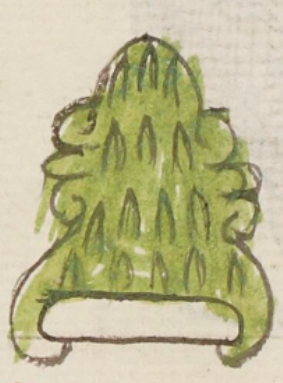Huitztepec (TR27r)
This compound glyph for the place name Huitztepec shows a group of sharp points meant to symbolize thorns or spines (huitztli). These appear on the front of a hill or mountain (tepetl). This upright, bell-shaped mountain is painted green, has curly rocky outcroppings on its slope, and has a horizontal white band at its base.
Stephanie Wood
Thorns or spines were used for self-sacrificial blood-letting from the ears and lower lip of human beings. Some were decorated for ritual use, such as the chalchihuitztli (see below). In the Codex Mendoza, spines have a turquoise blue color, suggesting preciosity, and what appears to be blood also coats the sharp edge, calling to mind the blood-letting (tlacoquixtia).
Stephanie Wood
viztepetl
Huitztepetl (or better, Huitztepec)
ca. 1550–1563
Jeff Haskett-Wood
spines, espinas, thorns, nombres de lugares

huitz, to come, or come back, https://nahuatl.wired-humanities.org/content/huitz
-tepec, on the hill or mountain, https://nahuatl.wired-humanities.org/content/tepec
La Montaña de Espinas
Stephanie Wood
Telleriano-Remensis Codex, folio 27 recto, MS Mexicain 385, Gallica digital collection, https://gallica.bnf.fr/ark:/12148/btv1b8458267s/f79.item.zoom
The non-commercial reuse of images from the Bibliothèque nationale de France is free as long as the user is in compliance with the legislation in force and provides the citation: “Source gallica.bnf.fr / Bibliothèque nationale de France” or “Source gallica.bnf.fr / BnF.”


